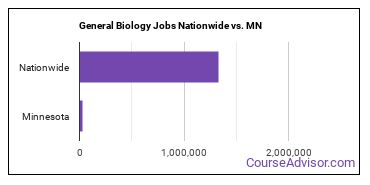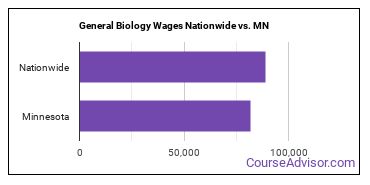Biology Schools in Minnesota
1,663 students earned Biology degrees in Minnesota in the 2022-2023 year.
In this state, Biology is the 11th most popular major out of a total 289 majors commonly available.
Education Levels of Biology Majors in Minnesota
Biology majors in the state tend to have the following degree levels:
| Education Level | Number of Grads |
|---|---|
| Bachelor’s Degree | 1,525 |
| Associate Degree | 81 |
| Master’s Degree | 45 |
| Doctor’s Degree (Research / Scholarship) | 12 |
| Doctor’s Degree (Professional Practice) | 12 |
| Doctor’s Degree (Other) | 12 |
Gender Distribution
In Minnesota, a biology major is more popular with women than with men.

Racial Distribution
The racial distribution of biology majors in Minnesota is as follows:
- Asian: 10.1%
- Black or African American: 8.1%
- Hispanic or Latino: 5.2%
- White: 66.2%
- Non-Resident Alien: 3.2%
- Other Races: 7.2%

Jobs for Biology Grads in Minnesota
There are 27,000 people in the state and 1,333,410 people in the nation working in biology jobs.

Wages for Biology Jobs in Minnesota
A typical salary for a biology grad in the state is $81,780, compared to a typical salary of $89,150 nationwide.

Most Popular Biology Programs in MN
There are 11 colleges in Minnesota that offer biology degrees. Learn about the most popular 11 below:
82% of students get financical aid. Most students complete their degree in 4.20 years. The full-time teacher rate is 82%.
Request InformationThe full-time teacher rate is 82%. Most students complete their degree in 4.45 years. 93% of students are awarded financial aid at this school.
Request InformationThis public college charges it's students an average net price of $17,812. The full-time teacher rate is 67%. The student to faculty ratio is 21 to 1.
Request Information12 to 1 is the student to faculty ratio. An average student at St. Olaf will pay a net price of $21,996. The full-time teacher rate is 71%.
Request InformationOf all the teachers who work at the school, 65% are considered full time. The student to faculty ratio is 16 to 1. Students who attend this public school pay an average net price of $14,719.
Request Information48% of the teachers are full time. 13 to 1 is the student to faculty ratio. Students who attend this private institution pay an average net price of $28,233.
Request InformationThe student to faculty ratio is 16 to 1. 59% of the teachers are full time. This public school has an average net price of $17,699.
Request Information91% of students get financical aid. Students who attend this private institution pay an average net price of $29,697. 10 to 1 is the student to faculty ratio.
Request InformationStudents enjoy a student to faculty ratio of 8 to 1. It takes the average student 4.05 years to graduate. Students who attend this private institution pay an average net price of $30,838.
Request Information100% of students get financical aid. Students enjoy a student to faculty ratio of 14 to 1. The full-time teacher rate is 32%.
Request Information100% of students get financical aid. The student to faculty ratio is 11 to 1. It takes the average student 4.07 years to graduate.
Request InformationBiology Careers in MN
Some of the careers biology majors go into include:
| Job Title | MN Job Growth | MN Median Salary |
|---|---|---|
| Medical Scientists | 13% | $83,670 |
| High School Teachers | 5% | $61,570 |
Related Majors in Minnesota
Below are some popular majors in the state that are similar to biology.
| Major | Annual Graduates in MN |
|---|---|
| Physiology & Pathology Sciences | 351 |
| Biochemistry & Biophysics | 350 |
| Neurobiology & Neurosciences | 212 |
| Ecology & Systematics Biology | 147 |
| Cell Biology & Anatomical Sciences | 80 |
| Biomathematics & Bioinformatics | 62 |
| Microbiology Science & Immunology | 50 |
| Other Biological Sciences | 38 |
View all majors related to Biology
Explore Major by State
Alabama
Arkansas
Connecticut
Florida
Idaho
Iowa
Louisiana
Massachusetts
Mississippi
Nebraska
New Jersey
North Carolina
Oklahoma
Rhode Island
Tennessee
Vermont
West Virginia
View Nationwide Biology Report
References
More about our data sources and methodologies.











